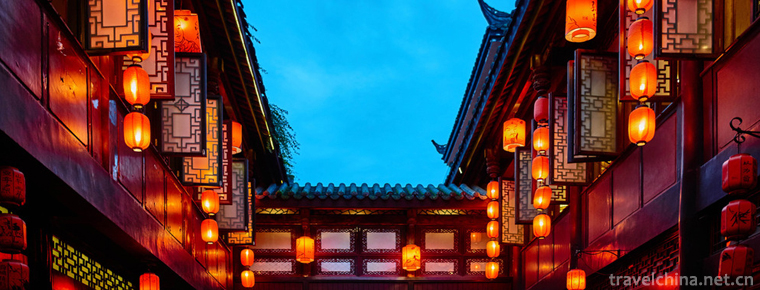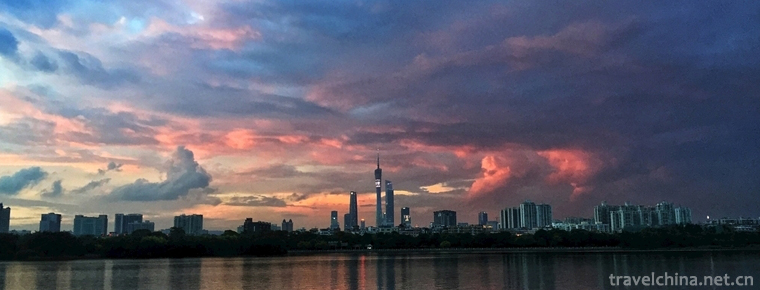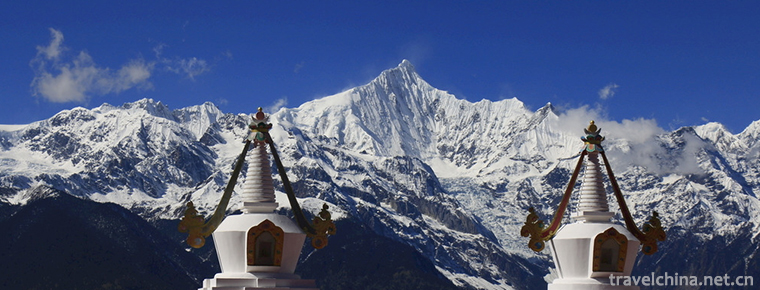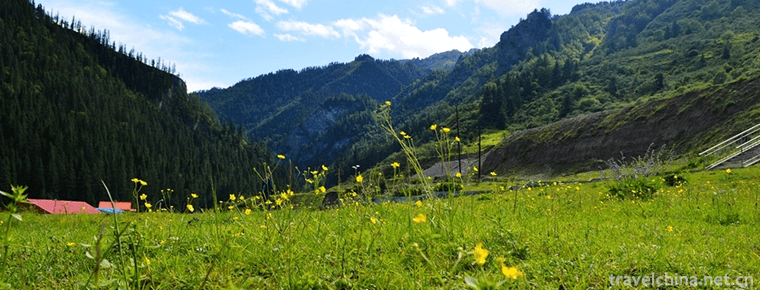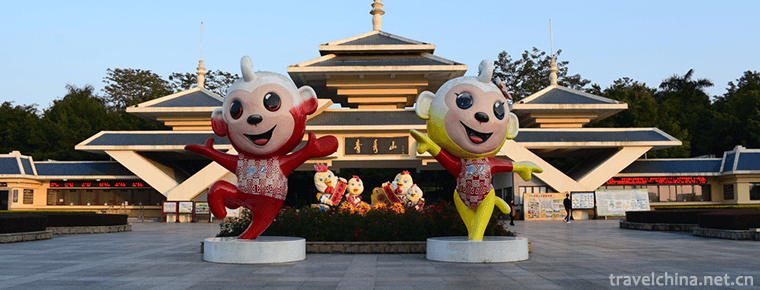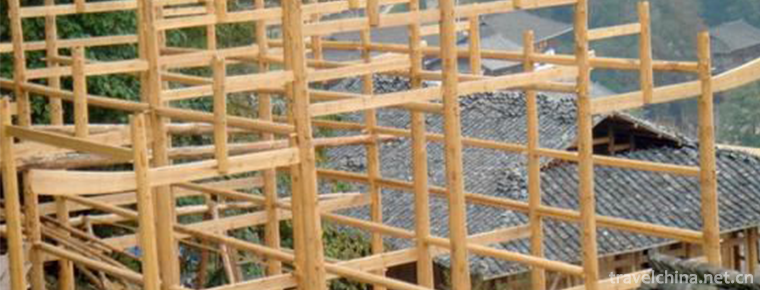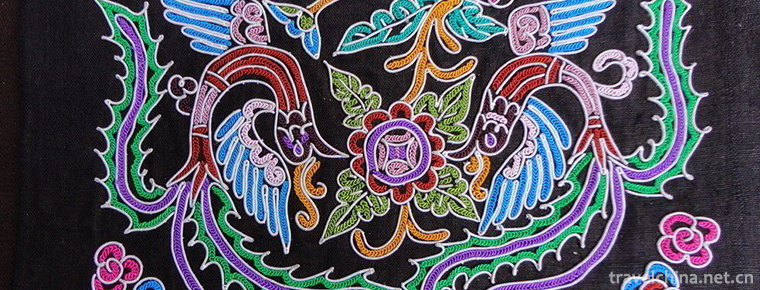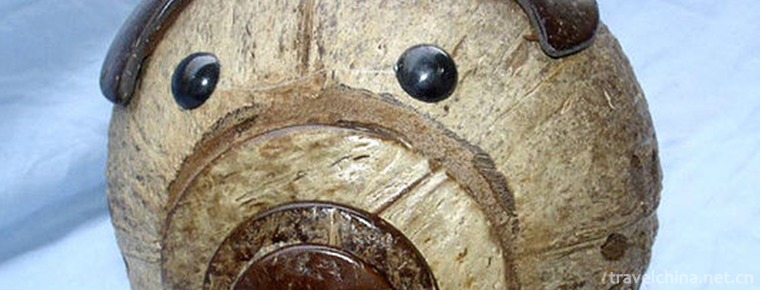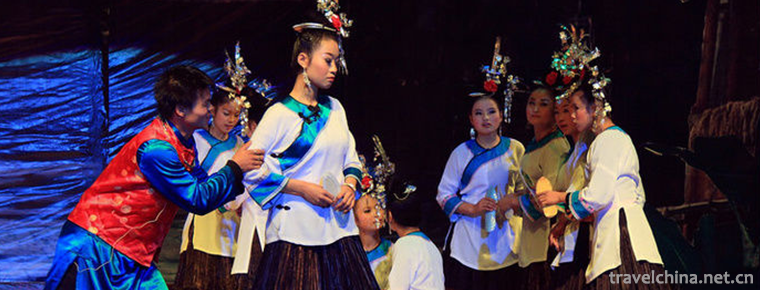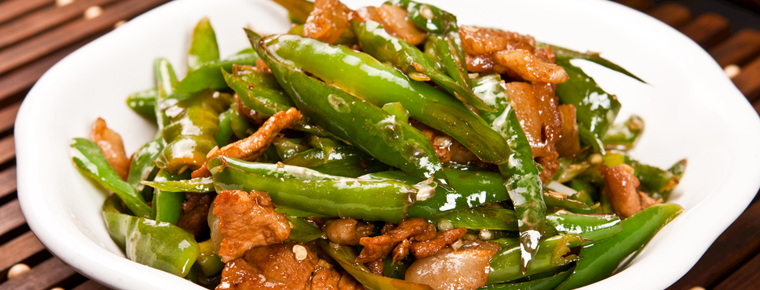Guangxi drama
Guangxi drama
One of the local operas of the Zhuang nationality in Guangxi. Yongju Opera belongs to the Pihuang Vocal Tune System, which originated in Hunan. It was formerly called Guangju Opera, Old Opera, Local Opera, Wuliuqiang Opera and so on. It was called Yongju Opera because its activity center was in the area of ancient Yongzhou and it was sung in Yongzhou (Nanning's ancient name) Mandarin. It is one of the four local operas in Guangxi. It was once spread in Guangxi, Guangdong, Yunnan, Guizhou, Vietnam and Cambodia.
The performance of Yong Opera is characterized by its rough and powerful lines, simplicity and magnificence, which is the combination of Southern martial arts and Western Guangdong style. Different from other operas, many statures, shapes, even shooting and foot-throwing originate from folk dances, martial arts and artistic forms which are popular with the Zhuang and Han nationalities in southwestern Guangxi. In some ways, they embody the strong and rugged national style of the Zhuang nationality.
On June 7, 2008, the Yongju Opera reported by Nanning City of Guangxi Zhuang Autonomous Region was listed in the second batch of national intangible cultural heritage list with the approval of the State Council.
historical origin
Qing Dynasty
Since the reign of Jiaqing and Daoguang in the Qing Dynasty, traditional Mandarin operas have been widely spread in Nanning and its surrounding areas. When
When theatre troupes perform in the local area of Nanning, theatre fans call them "local troupes". When theatre troupes perform outside, they are called "Nanning troupes", "Nanning Opera", "Old Opera" and so on. In 1933, when Nanning Businessmen held the "Recreation Club" to raise funds for the Red Cross Society, they marked the word "Yongju" for the first time, competing with Guangdong Opera and Guiju Opera.
At the end of the Qing Dynasty, Yong Opera had spread in central and southern Guizhou, and even in Vietnam and other Southeast Asian countries was greatly welcomed.
At the end of the Qing Dynasty, most of the opera troupes of Yong Opera were established by famous artists, such as the four local classes that were very popular at that time, namely, Quanxinfeng, Hexinfeng, Shouxinfeng and Yueyaotian. So at that time, the theatre troupes were mostly "family troupes", and the inheritance of the purpose of the play was mostly taught to the apprentices by the word "master" and "trick". At the end of Qing Dynasty, Nanning's most famous "family class" belonged to Leyao Tianban, which was founded by Jiang Zuyou. Its "Da Long Peng" was very famous, and it had the reputation of "opera champion yuan".
At the beginning of the Republic of China, because people had more demand for theatre, Yong Opera Troupes were set up one after another, the most famous of which was the Military and Civil Music Troupe sponsored by Lu Rongting. Lu Rong
When Ting was young, he wandered in Longzhou, Nanning and other places because of the crime was pursued by Qing troops. During the escape, Lu Rongting skillfully fled to the opera troupe of Jiaojiao Gui (Liu Yutang). Jiaojiao Gui was kind-hearted and hid him in the box of his costume, so Lu Rongting escaped from the disaster. Later, the former beneficiaries turned their feet to Gui's poverty, and Lu Rongting became the governor of Guangxi. In order to survive and meet Lu Rongting, Lu Rongting personally went out to greet the ragged performer of Yong Opera. He entertained him with good wine and good dishes, and allocated more than 15,000 silver yuan to set up a military and folk music troupe to let him sing in the troupe. Military and civilian music troupes became the first Nanning local theater troupe in Guangxi at that time. They often performed for officers and soldiers in Nanning, Longzhou and Zuojiang, and they were very popular.
the period of the war of Resistance Against Japan
During the Anti-Japanese War, theatre performers also expressed their patriotism on the stage. When Jiang Dazeng, Jun Songling and other Yong opera artists performed in Longan, they changed their past love drama and staged "High Peace in Blood War". According to the introduction, when the local opera is singing on the stage, the fans are also full of passion and stand up and sing along with the artist's words. With the entry of Japanese invaders into Guizhou, many Yong opera artists abandoned their homes and fled. During their escape, they preferred to sell sweet potato water and open tea houses to maintain their livelihoods, rather than whitewash peace for the invaders. Since then, the development of Yong Opera has entered a stagnation period.
Reform and Opening-up
In 1949, the liberation of the whole country created a new world for the development of culture and art. In January of 1951, the relevant departments of Nanning organized the street performers, established the Yongju troupe, and built the Yongju theater (now the Nanning shadow Theatre) as a permanent training and performing place for the theatrical troupe. From the mid-1950s to the early 1960s, Yong Opera once showed a vibrant scene with great charm.
The distribution areas of Yongju Opera include Nanning City, Chongzuo City, Baise City, Laibin City, Guigang City, Fangchenggang City, Funing City and Hekou County in Yunnan Province, and radiate to ASEAN countries such as Vietnam and Cambodia.
artistic characteristics
Performing Formula
Yongju opera has its own unique performance programs, such as "hair throwing", "palace boy", "lady-in-law", "horse-step", "jumping platform", "crossing mountains", and many other unique special skills, such as "vomiting blood", "eighteen arhats", "Qigong changing face", "Luo Hao Gong", "Fan Yagong", "Du Kou Gong", "Du Kou Gong", "Du Kou Gong", "Du Gong". "Tongue Flower Gong", "Pigtail Gong", "Yin and Yang Eye", "Double Mirror", "Big Mountain Crossing", "Lotus Block" and so on.
Performing Style
The performance style of Yongju opera is simple and rugged. Its literary and operatic performances are exquisite and pay attention to the expression of the inner feelings of the characters. Wudao is rough and fierce, its performance is exaggerated and spicy, and it pays attention to hard bridges and solid horses. Fists, knives, guns, forks, sticks and swords have their own routines, which are quite different from other kinds of operas. Many statures, shapes, even shooting and foot throwing all originate from folk dancing postures, martial arts and artistic shapes that the Zhuang and Han nationalities in southwestern Guangxi share. Some aspects reflect the strong and rough national style of the Zhuang nationality.
Performing characteristics
The performance of Yong Opera is characterized by its rough and powerful lines, simplicity and magnificence, which is the combination of Southern martial arts and Western Guangdong style. Among them, the traditional Wugong stunts of Yong Opera are welcomed by the audiences, such as "changing face", "playing fangs", "jumping platform shovel chair" and other Wugong stunts show the performers'deep artistic skills. Wugong of Yongju Opera belongs to the "Southern School", which is different from the "Northern School" in its lightness and dexterity. The Yongju Opera was calm and brave in its martial arts. It hit the "Five-color Real Armament" in a big way, and trained on the stage with a shining real knife and gun. It could not be performed without a solid foundation of martial arts. At that time, the absolute tactics that attracted the audience most were as follows. :
First, Li Mingyang's "face change". Li Mingyang, the third leader of the delegation, has his own "treasure of town and mountain". In Yong Opera "Li Huai sells arrows", his role Li Huai was teased by his grandson, and his face suddenly changed: from blue to red, then from red to green, when red, red to the top, green to frightening. Li Mingyang's change of face is not expressed by facial makeup as Sichuan Opera does, but by Qigong, which is a real skill.
The second is "playing with tusks", which is the stunt of the old artist Jiang Mingfu. The tusks are made from the canine teeth of wild boars or old sows, which are more than two inches long. Jiang Mingfu, who plays the face of flowers, needs to have four long tusks in his mouth in order to better show the fierceness of the characters in the play. In order to keep the tusks from falling out, the tusks must be filled with lead beforehand so that the weight of the tusks can be concentrated in the back. When not needed, put all four tusks into the mouth. When needed, depend on the stirring of the tip of tongue and the joint of teeth, push the four tusks out to make various gestures, either to close or spit, or to intersect the tip of teeth, or to fight with each other, so as to show the ferocity of the flower face thoroughly and vividly.
The third is the old artist Liu San's "smashing the stage". Liu San, who was over the age of Huajia at that time, could perform "smashing the stage" without any ambiguity. In the middle of the stage, stack three tables together, add a chair on top, and put a table beside it. Liu San climbed up the high chair, turned over one heel, smashed his back on the table beside him, smashed it to pieces, but people were safe and sound. This was the finale of the martial arts performance at that time.
This kind of martial arts stunt makes countless audiences fascinated and amazing, which is the most attractive part of Yong Opera. Unfortunately, most of the stunts are not easily handed down. Even if Master wishes to pass them on, it is not an overnight achievement to practice success. So many stunts have been lost, and later generations can only imagine the magic in the description of the old artists.
Musical Aria
There are four types of performances in Yong Opera: life, dan, Jing and ugliness. Most of its vocal tunes are pihuang tunes (north-south road), supplemented by Anqing tune, seven and a half sentences (Luoluo tune), cylinder-filling tune and local minor. Musical accompaniment mainly includes gongs, cymbals, two strings and larynx.
theatrical speech
The language of Yong Opera is in Southwest Guangxi Mandarin, and contains a large number of folk idioms, vocabulary, proverbs, Xiehouyu, etc. in vernacular, Hakka, Pinghua and Zhuang dialects.
Yong Opera Facebook
There were more than one hundred faces in Yongju opera, and they were multi-special. Black, red, white, green and yellow are commonly used, and sometimes blue, grey and gold are also used. The content of its color expression is to illustrate the skin color and the character characteristics, and to reflect the traditional customs and local cultural characteristics of Lingnan people.
Representational repertoire
According to incomplete statistics, there are more than 700 traditional operas of Yong Opera, and 418 conserved operas. This dramatic culture with regional characteristics is the crystallization of Lingnan folk art and has special value.
The traditional repertoires of Yong Opera mainly include: Wutai Hui Brother, Xihe Hui Wife, Sanjin Shi, Changshengle, Qizhuang Paper, Jiluying Recruitment for Kinship, Overlord Returning to Heaven, Yang Bajie Moving Troops, Hundred Birds Clothes, Chunman Counter, Wang Liulang, Red Bowl Record, Chen Tangguan, etc.
Inheritance and Protection
In 1969, due to historical reasons, the company was forced to dissolve, which led to the loss of audience and the shrinkage of the market. The drama slipped into a "tired period" and even disappeared for a time.
In order to better inherit and develop Yongju, since 1987, the relevant departments in Nanning have launched a series of rescue work on Yongju. In 2006, Yong Opera was listed in the first list of intangible cultural heritage at Guangxi Zhuang Autonomous Region level.

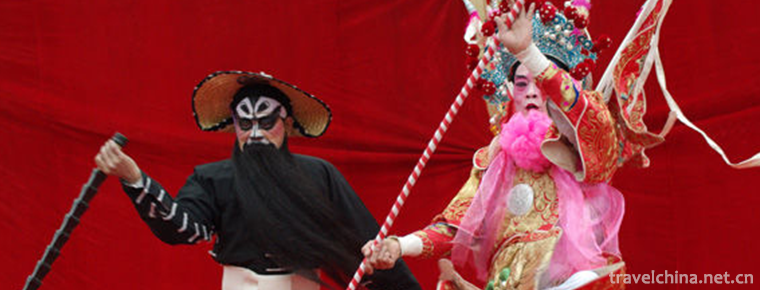
-
Jinli Street
Address:No. 231, Wuhou Temple street, Chengdu, Sichuan,China.
Views: 132 Time 2018-09-29 -
Canton Tower
Located in Guangzhou Haizhu District (Yizhou Island) near the Chigang Tower,.
Views: 160 Time 2018-10-12 -
Meili Snow Mountain
Meili Snow Mountain, located in the eastern part of Chayu County, Tibet, and the western part of Jingyunling Township, Deqin County, Diqing Tibetan Autonomous Prefecture, Yunnan Province.
Views: 186 Time 2018-11-13 -
The Qiaos Famaily Compound
The Qiao's Famaily Compound: National AAAAA-level tourist attractions, national key cultural relics protection units, national second-level museums.
Views: 153 Time 2018-11-24 -
Dayugou Scenic Area
Dayugou Scenic Area is located in Dayugou, Muer Township, Zhuoni County, Gannan Tibetan Autonomous Prefecture. It is 12 kilometers away from the county seat and has a total area of 105214.6 hectares..
Views: 163 Time 2019-01-07 -
Qingxiushan Mountain
Qingxiushan Scenic Area is a national AAAAA scenic spot in Nanning. Qingxiu Mountain is a key scenic spot in Nanning. In addition to protecting and restoring the original historic sites.
Views: 222 Time 2019-02-07 -
Shui Dong gou
The Shuidonggou scenic spot in Ningxia is the earliest Paleolithic cultural site excavated in China. It is known as the birthplace of Chinese Prehistoric Archaeology.
Views: 144 Time 2019-02-08 -
Construction Techniques of Miaozhai Diaojiao Building
Miaozhai hanging-feet building is evolved from the form of "nest dwelling". It is built with bamboo and wood. The lower part of the building is hollow. It is called "semi-dry fence".
Views: 108 Time 2019-06-05 -
Aquatic horsetail embroidery
Horsetail embroidery is a special embroidery technique inherited from generation to generation by Chinese aquarium women, which is the oldest and most national characteristic. It takes horse tail as a.
Views: 130 Time 2019-06-16 -
Coconut carving
Coconut sculpture is made of coconut shell, coconut palm and coconut wood as raw materials, and is carved into various practical products and plastic arts by hand. Coconut sculpture is one of the spec.
Views: 144 Time 2019-07-11 -
Zhulang Niangmei
Zhulang Niangmei is a work of Dong Opera in Guizhou Province. At the end of the Qing Dynasty, Liang Yaoting and Liang Shaohua, Dong opera masters in Congjiang County, Guizhou Province, adapted Dong dr.
Views: 140 Time 2019-08-10 -
Fried meat with chili
Stir fried meat with chili is a dish made with chili and streaky pork as the main ingredients and soybeans, garlic seeds, soy sauce, oil salt, monosodium glutamate and ginger as auxiliary ingredients..
Views: 212 Time 2020-03-18
